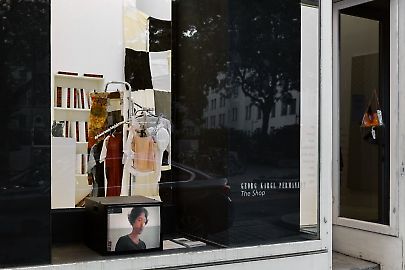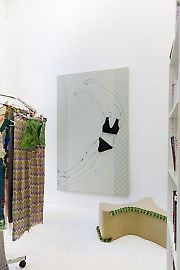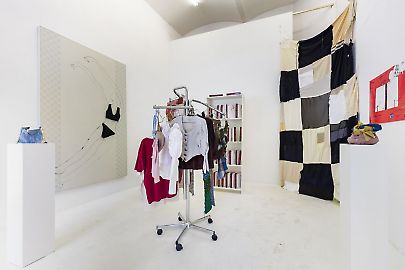The Shop -- curated by Rosa Rendl
The Shop
curated by Rosa Rendl
AB
4secco
Hulfe
Knuddi2000
Lonely Boys
Malumer
Nicole Maria Winkler
PMS
Rosa Rendl
VM
Events:
Thursday, July 9 2020, 8pm
Olivia Karabacek´s Greatest Hits
Performance
Saturday, July 25 2020, 7pm
Tipsy Tina
Performance
under the direction of Anna Hostek
equipment: 4secco
participants: Aline Rainer, Henrietta Rauth, Miriam Adefris
Press release:
A shop as a show as a shop as a show
Q: What is the relevance of fashion to art?
A: Good art should not look at fashion but good fashion can look at art *.
Art and fashion have forever been entwined, as two sisters too close in age to understand who’s influencing the style of whom. You could talk about Coco Chanel’s collaboration with Pablo Picasso on a series of costumes and scenery for the Balletts Russes in 1920s or about designer Elsa Schiapparelli’s endless exchanges throughout the 1930s and 1940s with Salvador Dalì, Alberto Giacometti and Meret Oppenheim; Sonia Delaunay designed clothes and textiles in tandem with her vivid artworks, and Yves Saint Laurent returned to art again and again throughout his career.
The list is endless.
Sketch a pattern, measure the waist
But as every love story there are two sides of the narrative, in this case influenced by social, political, economic and aesthetic timely conditions. Usually portrayed as bohemian figures detached from financial dynamics, artists in the late 1980’s became increasingly interested in quicker forms of exchange-value and the exposure that fashion could provide.
Can Capitalism be a freeing tool?
Cut, measure an arm, measure the length
The 1990’s were characterised by a strong focus on independence and collaboration between peers, as it was Sarah Lucas’s and Tracey Emin’s iconic East London project The shop, mainly selling cheap merchandising and operating as community hangout, or Susan Cianciolo experimenting with deconstructed DIY elements from her studio in Downtown NY. The collective Bernadette Corporation was initially conceived as a morphing identity playfully engaging with the high fashion system. Catwalk shows featured mascots in bear costumes and, once, a group of cheerleaders.
The unconventional brand BLESS, active between Paris and Berlin, extended the idea of fashion to products and accessories imagined as a holistic life-style. The 2000s were marked more by achieving economical sustainability in rapidly gentrifying corporatised cities, whilst the digital revolution, social media and the 2008 financial crisis saw the emergence of distributed forms of existence and precarious labour conditions.
What are the possibilities of politicizing alternative identities?
Neck, shoulder line, back
The Shop curated by artist Rosa Rendl for Georg Kargl PERMANENT space showcases the work of artists engaging with fashion, design and merchandising. Maintaining ‘in spirit’ the punk-attitude of Emin and Lucas’s shop of the same name, Rendl wants to create a community hangout and peer platform whilst presenting the fluid intersection of these fields. The gaudy PMS (Premenstrual Syndrome) T-shirts by artist Marlie Mul, hang near the surreal body extensions designed by Hulfe, the project of artists Lilli Thießen and Daphne Ahlers. Lonely Boys -Rendl’s sound collaborative alter ego with Ahlers- merchandise also appears throughout the space. Pluriball and recycled packaging form the experimental shopping bags of Knuddi2000 developed by artist Schirin Charlot whilst second-hand clothes and Trachten garments become new items in the infinite cut and paste reconfigurations by 4secco, the joint venture of Anna Hostek and Katharina Strak. VMT (Vaginal Mystery Tour) sculptural wearables, a collaborative project by artists Seyoung Yoon and Joon Yeon Park, play with prints, pop-culture and objects, whilst the absurd Malumer pieces created by artist Luna Mae Heflin are at once clothing, painting, and sculptures, willingfully ignoring any form of expertise and classical tailoring in their making. Rendl swimwear collection is displayed pinned on an AB patterned canvas, a collaboration between artist Adrian Buschman and the historical textile company Backhausen. Reinforcing the cobweb of connections across artistic positions, the exhibition becomes a retail platform and a laboratory to test the current status of the art object. Peer to peer, and featuring a series of practitioners that playfully experiment with their work, even the show has a double identity.
The shop is a show as shop as a show.
Text by Attilia Fattori Franchini
*I-D Magazine. April 2001, ‘The Gallery Issue’.




